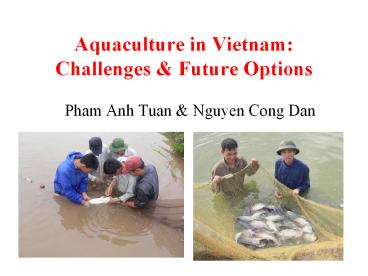Aquaculture in Vietnam: Challenges - PowerPoint PPT Presentation
1 / 33
Title: Aquaculture in Vietnam: Challenges
1
Aquaculture in Vietnam Challenges Future
Options
- Pham Anh Tuan Nguyen Cong Dan
2
Presentation outline
- Introduction to aquaculture fisheries
- The vision for development of the sectors
- Challenges needed to be solved
- Activities to solve challenges
- The future of the sector
3
(No Transcript)
4
Fisheries Aquaculture in Vietnam
- One of the most dynamic and fastest growing
sectors - Last 15 years total fisheries production
approximately 2.9 times increased, to 3.1 million
tonnes in 2004 - Fisheries export value has increased nearly 12
times to US 2.4 billion in 2004
5
Fisheries Aquaculture in Vietnam
- Supplies 40 of animal protein in Vietnamese food
- Creates approximately 4 million jobs and support
livelihoods for many more - Contributes to approximately 4 GDP
- Fishery landings has increase from 0.7 billion MT
in 1990 to 1.7 million MT in 2004 - Estimated sustainable yield 1.4 - 1.5 million MT
6
Aquaculture in Vietnam
- Aquaculture production from 0.4 million MT in
1990 to 1.4 million MT in 2004 - Main freshwater species cultured are
- Carps
- Catfish
- Tilapia
- Gouramy
- Silver barb
7
Pond Aquaculture
- Larger commune level ponds or smaller household
ponds - Utilises many species including tilapias
- Integrate fish culture with vegetables and
livestock
8
Lowland rice fish
- Deep water rice often used
- Practiced throughout the Red Mekong river delta
- Fish culture extended after rice harvest
9
Sewage fed systems
10
Cage aquaculture
11
Aquaculture in Vietnam
- Main brackish marine species cultured are
- Black tiger shrimp
- Black kingfish
- Mud Swimming crabs
- Grouper
- Green mussel
- Abalone
- Lobster
- Seaweed
12
Brackish marine aquaculture
13
Aquaculture in Vietnam
- Potential area for aquaculture
- Freshwater
- Ponds and small lakes 120,000 ha
- Medium and larger Reservoirs 340,000 ha
- Rice-fields 580,000 ha
- Marine Brackish Water
- Tidal areas 600,000 ha
- Lagoons suitable for aquaculture 300-400,000 ha
14
The projected development of aquaculture in
Vietnam
- Aquaculture development (1999-2010)
- - Food security
- - Exportation for hard currencies
- Target objectives
- - 2,000,000 MT from aquaculture
- 2,5 billion USD from exporting of aquaculture
products - 2 million of jobs in aquaculture
15
Challenges needed to be solved
- Lack of planning leading to unsustainable
development - Poor seed quality and insufficient quantity
- Poor aquaculture infrastructure
- Inefficient extension service
- Polluting production technologies
16
Challenges needed to be solved
- High disease prevalence
- Lack of environmental and disease monitoring
system - Low species diversification
- Lack of administrative and management capacity
17
Activities to solve challenges
- Lack of Planning
- -Aquaculture planning guidelines for provincial
and district level - -Detailed project planning and implementation
- -Training of national and provincial planning
staff
18
Activities to solve challenges
- Poor Seed Quality Insufficient Quantity
- - Establishment of selective breeding programmes
- - Development of Better Management Practices
(BMP) in hatcheries - - Seed quality evaluation and monitoring
- -Training of public and private hatchery
management staff
19
Activities to solve challenges
- Poor Aquaculture Infrastructure
- - Establishment of 6 National Broodstock Centers
- - Establishment of provincial hatcheries
- - Establish demonstration areas with common in-
and outlet water canals for semi-intensive
aquaculture production
20
National Broodstock Centres
NBCs
Provicial seed centres
Commercial hatcheries
21
National Broodstock Center
22
Improved infrastructure for a Semi-intensive
shrimp
23
Activities to solve challenges
- Inefficient Aquaculture Extension
- - Support provincial aquaculture extension
centres - - Establish Aquaculture Farmer Field Schools
- -Training of trainers in Good Aquaculture
Practices (GAP)
24
Aquaculture Farmer Field School
Stress testing tiger shrimp seed to evaluate
quality
25
Polluting Production Technologies
Shrimp waste accumulated in outlet
Intensive shrimp pond cleaned by Tilapia.
26
High Disease Prevalence
- Study on parasite, bacteria diseases in fish
cultured in pond/cage - Studies on reducing viral diseases e.g. white
spot disease in shrimp culture
27
Activities to solve challenges
- Lack of environmental and disease monitoring
dissemination system - - 3 Environmental Disease Monitoring
Centers established - Essential for detection of emergencies
- Early warning and response
- Prevention of disease
- Reduce risk of production failure
- - Community based management
28
Activities to solve challenges
- Low Species Diversification
- Promote diversified production systems
- Mono polyculture
- Integrated systems
- Culture species diversified
- Low and high value species
- Local introduced species
- Market targets
29
Activities to solve challenges
- Lack of Policies to Support Sustainable
Development - Development of
- - The New Fishery Law
- - Environmental Impact Assessment Guidelines
- - Aquaculture Planning Guidelines
- - Co-management Guidelines
30
Activities to solve challenges
- Lack of administrative and management capacity
- - Human Resource development plan
- - Education and additional training
- - CP 43 Organizational restructuring of the
Ministry of Fisheries related institutions
31
Activities to solve challenges
- Great support to fisheries aquaculture
- - Gov. budget for fisheries increased
- - Strong long term support of international
donors - DANIDA (FSPS)
- NORAD
- WB ADB
32
Future of the sector
- Diversification
- More intensive farming
- Market oriented development
- Balance of domestic international consumption
- Importance of quality control success of farming
trading
33
Thank you!































